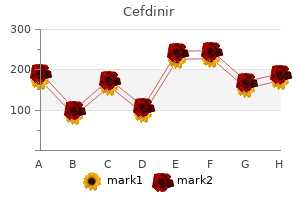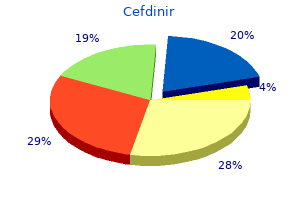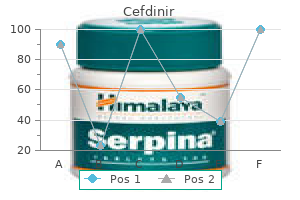Cefdinir
"Cheap 300 mg cefdinir amex, antibiotic with birth control pills".
By: V. Jose, M.A., M.D., Ph.D.
Co-Director, Burrell College of Osteopathic Medicine at New Mexico State University
Although frequently self-limiting virus que esta en santo domingo purchase 300mg cefdinir overnight delivery, these disorders have the potential for chronicity and serious articular injury to infection taste in mouth buy cefdinir with visa the peripheral or axial joints antibiotics for sinus infection for adults buy generic cefdinir 300mg line. The prevalence of reactive arthritis after epidemics of Shigella dysentery has documented the arthritogenicity of this organism. In most circumstances, the diarrheal illness resolves before the articular signs appear. Salmonella typhimurium is the commonest Salmonella species inducing reactive arthritis. A sterile arthropathy will develop in as many as 6 to 10% of contaminated people within three weeks of a Salmonella outbreak. No medical differences between Shigella- and Salmonella-induced reactive arthritis have been observed. Yersinia arthritis most commonly affects young adults as an acute, self-limiting gastrointestinal illness that will have related joint complaints in 50% of circumstances. The arthritis is predominantly oligoarticular, usually affects the lower extremities and palms, and should run a chronic or relapsing course. Chronic low back pain and sacroiliitis are seen in a single third of sufferers, but extreme spinal ankylosis is rare. Sustained elevations of IgA antibody titers correlate with persistent infection, chronic arthritis, and occult enteritis. However, acceptable antibiotic remedy should be used in sufferers with persistently positive stool cultures for Yersinia. Arthritis will develop in as many as 1 to 3% of sufferers with chlamydial urethritis. The incidence of Chlamydia-induced arthritis has been estimated to be 5 circumstances per a hundred,000 per 12 months. The analysis is suggested recommended|is recommended} by the presence of persistent arthritis in at least of|no much less than} one joint, signs of genitourinary infection, detection of IgG or IgA anti- Chlamydia antibodies, or Chlamydia present in genitourinary swabs or urine culture. A chronic arthropathy develops in additional than half, with almost one third having inflammatory low back pain, enthesitis, or radiographic sacroiliitis. Chlamydia-induced arthritis apparently responds to antibiotic remedy, which is indicated in culture, serologic (IgM or IgA), or polymerase chain reaction-positive sufferers. The arthritis evolves in two main patterns: (1) an additive, asymmetrical polyarthritis or (2) an intermittent oligoarthritis that most commonly affects the lower extremities. Enthesitis, fasciitis, conjunctivitis, and urethritis are early and prominent signs. Although most circumstances come up in sufferers with established, energetic cutaneous illness, other sufferers (especially children) have articular illness that antedates the event of psoriasis. Although the extent of psoriatic pores and skin illness correlates poorly with the onset of arthritis, the danger of psoriatic arthritis increases with a family history of spondyloarthropathy or extensive nail pitting. The age of onset is usually between 30 and 55 years, and psoriatic arthritis has been proven to have an effect on} men and women equally. No etiologic agent or reactive process has been proved, although stress, trauma, the expression of heat shock proteins, and antecedent infection with Streptococcus or Staphylococcus have been instructed to play a job. The histopathology of psoriatic synovitis is much like that seen in other inflammatory arthritides, with a notable lack of intrasynovial immunoglobulin and rheumatoid issue manufacturing and a higher propensity for fibrous ankylosis, osseous resorption, and heterotopic bone formation. The 2nd variant involves the distal interphalangeal joint and is seen in 10 to 15% of sufferers. It is strongly associated with nail modifications of pitting, onycholysis, subungual hyperkeratosis, transverse ridging, and/or leukonychia (Fig. Finally, arthritis mutilans is seen in 5% of sufferers and is manifested as a harmful, erosive, polyarticular arthritis affecting the palms, ft, and spine. Hyperuricemia additionally be} discovered and sometimes correlates with the severity of cutaneous psoriasis. The typical "pencil and cup" deformity could develop in sufferers with distal interphalangeal joint illness or arthritis mutilans. Acro-osteolysis, paravertebral ossification, and pericapsular calcification have additionally been described.

Other tissue specimens similar to lymph nodes antibiotics before tooth extraction cheap 300 mg cefdinir fast delivery, liver bacteria 1 negative hpf buy discount cefdinir on line, and gastrointestinal mucosa outline the extent of mast cell involvement but are obtained solely as necessary infection behind the eye purchase discount cefdinir. In all categories of mastocytosis, a major objective of treatment is to management mast cell mediator-induced signs and signs similar to anaphylaxis, gastrointestinal cramping, and pruritus. H1 receptor antagonists similar to hydroxyzine and doxepin are useful in reducing pruritus, flushing, and tachycardia. If insufficient aid occurs, including an H2 antagonist similar to ranitidine or cimetidine may be be} beneficial. However, many sufferers proceed to complain of bone ache, headaches, and flushing, which result in half from the lack to block other mast cell mediators. Disodium cromoglycate (cromolyn sodium) inhibits the degranulation of mast cells and will have some efficacy within the treatment of mastocytosis. If subcutaneous epinephrine is insufficient, intensive therapy for anaphylaxis ought to be instituted. Patients with recurrent episodes of anaphylaxis may have H1 and H2 antihistamines prescribed to lessen the severity of assaults. Episodes of profound anaphylaxis may be be} spontaneous but have also been noticed following stings from insects or the administration of radiocontrast media. Treatment of gastrointestinal illness is directed at controlling peptic signs, diarrhea, and malabsorption. Gastric acid hypersecretion leading to peptic signs and ulcerations is controlled with H2 antagonists and proton pump inhibitors. In sufferers with severe malabsorption, systemic steroids have been proven to be efficient. One affected person with portal hypertension was successfully managed with a portacaval shunt. Another affected person with exudative ascites was handled successfully with systemic steroid therapy. Patients with mastocytosis and an related hematologic dysfunction are handled as dictated by the specific hematologic abnormality. A latest study advised that splenectomy may enhance survival in sufferers with poor prognostic types of mastocytosis. One study discovered seven variables that have been strongly associated with poor survival, including constitutional signs, anemia, thrombocytopenia, abnormal liver function exams, lobated mast cell nucleus, a low percentage of fat cells within the 1469 bone marrow biopsy, and an related hematologic dysfunction. Other poor prognostic variables embrace the absence of urticaria pimentosa, male gender, absence of pores and skin and bone signs, hepatomegaly, splenomegaly, and normal bone radiographic findings. As a group, sufferers with indolent mastocytosis and pores and skin involvement alone have one of the best prognosis. Among youngsters with isolated urticaria pigmentosa, at least of|no less than} 50% enhance by adulthood. Diffuse cutaneous mastocytosis is usually associated with indolent systemic illness. Patients with mastocytosis and an related hematologic dysfunction have a variable course, relying on the prognosis of their hematologic dysfunction. Survival with lymphadenopathic mastocytosis and eosinophilia is 2 to 3 years without therapy. Describes patterns of gastrointestinal illness in mastocytosis and the implications for medical management. A prospective study of laboratory and morphologic features and their relation to prognosis. Initial report of a mutation in c-kit in sufferers with mastocytosis and aggressive illness. The essential position of the thymus is to generate clonally various T lymphocytes that may acknowledge an enormous array of international proteins presented as peptides on host cells. An essential parallel thymic function is eliminating self-reactive T-cell clones that could damage normal tissue. The embryonic thymus is fashioned initially from epithelial cells lining the third and 4th pharyngeal pouches. These specialized epithelial cells migrate through the neck region to type bilateral thymic lobes within the higher anterior mediastinum.

Thus antibiotics mnemonics buy cefdinir cheap online, the rate of carbohydrate absorption virus 07 buy cefdinir 300 mg with visa, the timing nicely as|in addition to} the amount of insulin and glucagon secreted antibiotics for uti infection symptoms cheap cefdinir 300mg line, the ability of the liver to retailer and subsequently release glucose, nicely as|in addition to} the response of the liver, muscle, and fats to insulin and counter-insulin hormones all interact to reduce the rise in glucose concentration after a meal nicely as|in addition to} to guarantee a clean return of glucose concentrations to preprandial levels through the transition from the fed to the postabsorptive state. Regulation of Glucose Concentrations within the Fasted State the contribution of gluconeogenesis turns into progressively extra necessary because the period of quick is extended and hepatic glycogen shops are depleted. The price of glycogen depletion decided by} a variety of|quite so much of|a wide selection of} factors, together with antecedent food regimen and train, however type of} complete after 24 to 48 hours of fasting. Anything that lowers the demand for glucose lessens the need to|the necessity to} break down protein shops. This is completed by changing from a primarily carbohydrate-based metabolism within the fed state to a primarily fat-based metabolism within the fasted state. Insulin decreases and glucagon, development hormone, and cortisol concentrations all improve as hepatic glycogen is depleted and the glucose concentration falls. This change within the hormonal milieu stimulates lipolysis and ketogenesis, which results in|which leads to|which ends up in} a rise in plasma glycerol, free fatty acid, and ketone physique concentrations. Free fatty acids are metabolized by muscle, liver, and different tissues in place of glucose. Free fatty acids also are transformed by means of ketogenesis to acetoacetate and beta-hydroxybutyrate, which can substitute for glucose as a gas for the mind. These metabolic variations normally allow glucose to progressively lower to 40 to 50 mg/dL throughout a fast without provoking signs of hypoglycemia. Inadequate glycogen shops or breakdown, insufficient gluconeogenesis end result of} defects in enzyme exercise, lack of substrate availability, or persistent elevations of insulin or insulin-like exercise, alone or together, could cause or exacerbate hypoglycemia. Recovery from Hypoglycemia If counter-regulation is intact, hypoglycemia (regardless of the cause) will lead to a lower in insulin secretion and a rise in glucagon, epinephrine, cortisol, and development hormone secretion. Epinephrine seems to turn out to be progressively extra necessary when hypoglycemia is prolonged or severe. Permissive amounts of cortisol and development hormone are required for a standard hepatic response to glucagon and epinephrine. Drugs or illnesses that inhibit counter-regulatory hormone secretion or action predispose to hypoglycemia. Symptoms of Hypoglycemia Symptoms of hypoglycemia have been categorised into two main teams: these arising from activation of the autonomic nervous system (autonomic) and those associated to insufficient glucose provide to the mind (neuroglycopenic). During acute insulin-induced hypoglycemia in healthy persons, autonomic signs are acknowledged at a threshold of roughly 60 mg/dL (3 mM) and impairment of mind function manifested by neuroglycopenic signs happens at a threshold of roughly 50 mg/dL (2. Variations among reports regarding allocation of signs to the autonomic and neuroglycopenic varieties may be be} ascribed to the forms of patients examined, diabetic versus nondiabetic, kind 1 versus kind 2 diabetes, medical versus experimental conditions, and, most likely most importantly, variations among persons regarding their perceptions of signs. During experimentally induced hypoglycemia in 20 persons with and 25 persons without diabetes, a principal element evaluation allocated sweating, trembling, warmness, nervousness, and nausea to the autonomic group and dizziness, confusion, tiredness, problem with speaking, headache, and lack of ability to focus to the neuroglycopenic group. In one other examine of 10 non-diabetic persons, partitioning of signs throughout insulin-induced hypoglycemia allocated shaky/tremulous, heart pounding, nervous/anxious, sweaty, hungry, and tingling to the autonomic group and warm, weak, problem thinking/confused, and tired/drowsy to the neuroglycopenic group. Shock *Mutations within the beta-cell sulfonylurea receptor gene, glutamate dehydrogenase gene, and glucokinase gene are rare causes of hyperinsulinemic hypoglycemia often manifested in infancy or childhood. None of the signs noted earlier, regardless of kind, is specific for hypoglycemia. Classification of Hypoglycemia A useful approach for the practitioner is a classification primarily based on medical traits (Table 243-1). Hospitalized patients are at additional danger for hypoglycemia often from iatrogenic factors. Evaluation of Hypoglycemia the path and extent of evaluation is dependent on the medical presentation. The healthy-appearing affected person with no coexistent illness who has a historical past of episodic signs suggestive of hypoglycemia requires an approach fairly totally different from the hospitalized affected person with acute hypoglycemia. Furthermore, reliance solely on a low blood glucose value to diagnose a hypoglycemic disorder fails to take into accounts risk of|the potential of|the potential for} laboratory error, artifactual hypoglycemia, and, indeed, that ordinary persons might have plasma glucose levels nicely beneath 50 mg/dL (2. It is necessary to recognize that a standard plasma glucose concentration (when measured reliably) obtained through the incidence of spontaneous signs absolutely eliminates risk of|the potential of|the potential for} a hypoglycemic disorder; no additional evaluation is required!

Insulin-Secreting Tumors Insulinomas are the commonest kind of islet cell tumor can antibiotics for acne cause weight gain 300mg cefdinir. As mentioned earlier on this chapter virus removal free download purchase cefdinir 300mg otc, these tumors trigger hypoglycemia antibiotics quotes discount cefdinir online american express, are usually small, and are often benign. Gastrin-Secreting Tumors Gastrin-secreting tumors are the second most typical kind of islet cell tumor. When untreated, these tumors are related to high charges of gastric acid secretion and intractable peptic ulcer disease. This group of symptoms is often referred to because the Zollinger-Ellison syndrome, which is mentioned in detail in Chapter 130. Glucagon stimulates glycogenolysis and gluconeogenesis, increases ketogenesis, and enhances hepatic amino acid uptake and oxidation. This rash usually begins as small erythematous lesions involving the lower extremities and perineal and perioral regions. The lesions may take the form of pustules or blisters, which frequently crust and merge. It is frequently accompanied by weight reduction, diabetes mellitus, stomatitis, and diarrhea. Venous thrombosis, stomach ache, peptic ulcer, and neurologic symptoms similar to ataxia, fecal and urinary incontinence, and visual symptoms additionally may occur. Glucagon-secreting tumors are identified by the presence of elevated plasma glucagon concentrations. Glucagon concentrations on the time of analysis are often higher than 500 pg/mL but, in some cases, only minimally elevated. The degree of elevation may depend upon the specificity of the glucagon assay, particularly its cross reactivity with precursor hormones and different glucagon-like materials circulating in plasma. Although diabetes, sepsis, renal failure, and familial hyperglucagonemia all may enhance plasma glucagon concentrations, these conditions not often pose a diagnostic problem outcome of|as a end result of} the indicators and symptoms of the glucagonoma syndrome are absent. Furthermore, clinically evident glucagon-secreting tumors are virtually all the time large and are often readily visualized with imaging strategies similar to computed tomography. Metastasis to the liver, lymph nodes, or bone are frequently present on the time of analysis. Although surgical resection of an malignant islet cell tumor healing, treatment is usually directed toward decreasing symptoms and enhancing quality of life. Reduction within the concentration of glucagon and different related hormones by surgical debulking, hepatic embolization, chemotherapy, or use of a somatostatin analogue to inhibit hormone secretion a marked improvement in symptoms. It is a member of the glucagon household of hormones and has numerous effects on the gastrointestinal tract, including stimulation of chloride secretion within the small gut and bicarbonate secretion within the colon. Pancreatic tumors are roughly 10 times more common then extrapancreatic tumors. Extrapancreatic tumors are likely to|are inclined to} be much less aggressive and often occur in youngsters as neuroblastomas, ganglioneuromas, or ganglioblastomas. Stool volume usually exceeds 3 L/day; a stool volume of lower than seven hundred mL/day makes the analysis unlikely. Streptozotocin alone or in combination with 5-fluorouracil may produce a prolonged remission. Somatostatin analogues a particularly useful adjuvant within the treatment of extreme electrolyte disturbances or during preparation of sufferers for surgical procedure or chemotherapy. Both pancreatic and extrapancreatic somatostatin-secreting tumors have been reported. At the time of analysis, these tumors are typically large and often metastatic to the liver, lymph nodes, and/or duodenum. Patients frequently present with non-specific complaints similar to weight reduction and stomach ache. Some present with diabetes, hypochlorhydria, cholelithiasis, diarrhea, and steatorrhea, a constellation of symptoms referred to because the somatostatinoma syndrome. These symptoms are presumed to be inhibition of insulin, gastrin, cholecystokinin, and pancreatic enzyme secretion respectively by the high circulating levels of somatostatin. Pancreatic somatostatinomas often are large and readily visualized by ultrasound or computed tomography.
